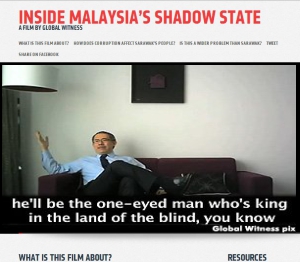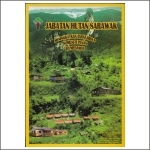Joseph Tawie
The deceitful and insidious manner by which the state government is going about with the construction of the Baram Dam has angered the Orang Ulu communities in the dam project vicinity.
Orang Ulu National Association Miri (OUNA) chairman Pete Kallang said: “As one of those affected I just can’t understand this injustice and this outrageous and abusive exploitation.
“Why, it could be seen as an act in complete disregard for our well-being and opinion.
“This could be proven by the priority given to the preparatory construction activities done even before the proper Social Impact Assessment (SIA) and the Environmental Impact Assessment (EIA) are completed or perhaps not even started and made accessible to affected and interested parties.
“In doing this, it seems the construction of the dam is to be implemented whatever the findings or recommendations that would eventually be available if and when the EIA or SIA is done,” he said.
Kallang added that during a recent meeting with the affected locals, he was shocked to hear the headman saying that the government would not build the dam.
“The reaction by this particular headman reflects the effectiveness of the discreet process practised in building the dam.
“The dam construction is one dark secret kept away from those living in Baram.
“If it is occasionally mentioned by the proponents, the subject would be down-played, and watered-down with downright euphemism.
Civilization under threat
The reality, he said, was different as reported in the media.
“We learned from newspaper reports and information dripping from the project supporters speaks of an affected area covering 38,900 hectares (389 sq km) or half of the size of Singapore island.
“It will be constructed of around 180 meters above sea level and will generate 1,200 MW of electrical power.
“At least 90% of the land mass which will be flooded by the dam reservoir will be the Native Customary Rights (NCR) land.
“Relocation of the 20,000 people to make way for the Baram Dam will definitely result in a permanent social damage.
He said the Kenyah and Kayan people traditionally live in longhouses and mass relocation of the people will no doubt spell the end of the traditional social structure.
According to Kallang the construction of the dam is a ‘senseless’ exploitation of resources “which is primarily driven by avarice coupled with immorality’.
“But for us who are directly and adversely affected parties, no one can blame us in thinking that this is a calculated, intentional and purposeful manoeuvre to wipe out our races.
“The dam will not only cause the colossal environmental devastation and severe consequences on the ecosystem, but it will also rage a permanent degeneration of the ethnic identity and heritage of the natives who live in the region.
Only big companies benefit
Kallang, who is also the chairman of the Kenyah Association in Miri, said whilst the bulk of those affected were from the Kenyah community, the other groups affected included the Kayans and Penans.
“These are also the same majority groups of people who are most affected by the Bakun Dam which has just been commissioned.
He added that Baram was the least developed part of Sarawak and arguably the least developed area in the whole of Malaysia.
“So far, the only so-called ‘developments’ which are seen in Baram are the colossal and exhaustive exploitation or extraction of the Baram natural resources.
“These are like the reckless harvestings of the timber, extraction of lime stone, sand dredging, vast oil palm plantations and now the dam for hydropower electrical generation.
“Practically all the beneficiaries of these so-called developments are big companies owned by big tycoons from outside the Baram.
“Most of the workers employed at these facilities are also from outside Baram and a lot of them are foreigners.
“To say that these “developments” bring employment is a fantasy; so we do not see how the Baram dam can bring significant economic opportunities for the locals.
“Any spin-off employment is just a pie in the sky for the people of Baram,” he said.























Peter Kallang rightfully deserves the admiration, respect and support of every concerned Orang Ulu in Telang Usan for his stand on the Baram Dam. There is no need to waste time reading the EIA or SIA reports on the dam because majority of the people within the dam’s vicinity are clearly against the project. For generations timber companies have been destroying our jungles and despite many attempts (especially by the Penans) to stop further destruction, the companies are still operating. The man who has become one of the richest among the Orang Ulu in Baram is the Temenggong who is said to have received a total of about RM30k per month from the companies operating in Baram.Is he the same person who has been lying to the BN government that he has the support of the majority on the dam project? It does not really matter to the BN government what the Temenggong says because the bottom-line is he is a “Yes” man to the BN government.
The people will see what is going to happen to the dam. We need some kind of sustainable contigency plans incase the matter goes to the extreme. For now, we humbly demand that the dam be STOPPED.
Comment by Pelaki Budung — September 4, 2011 @ 6:26 PM |
THIS ARTICLE WAS REPORTED BY THE BORNEO PROJECT
NO DAM FOR BARAM
http://borneoproject.org/updates/no-dam-for-the-baram-powerful-statement-from-the-chairman-of-the-orang-ulu-association
Comment by ANON — September 3, 2011 @ 4:49 PM |
REPOSTED FROM “THE BORNEO PROJECT”
No Dam for the Baram: Powerful statement from the chairman of the Orang Ulu Association in Miri
This press statement was released on the 29th of August, 2011.
“Flood from the dam and the infrastructure associated with the construction will definitely bring irreparable damage to the whole environment. It will destroy a heritage for which all Malaysian or human race should respect and harness.”
*******
NO DAM FOR BARAM
Besides the colossal environmental devastation and severe consequence on the ecosystem that the dreadful Baram Dam will bring, it will also rage a permanent degeneration of the ethnic identity and heritage of the populaces who live in the region. Based on the
number of villagers, the most affected are the Kenyah followed by the Kayan and Penan population. These are also the same majority groups of people who are most affected by the Bakun Dam which was just commissioned. The same like it was done in Bakun, the decision in building the Baram Dam seems to be in total disregard for all those who area affected. It is built for the benefit of others rather than those who live in Baram and for the long term good of the Baram.
As one of those affected I just can’t understand this injustice and this outrageous and abusive exploit. This seems to be a senseless exploitation which is primarily driven by avarice coupled with immorality. For us who are directly and adversely affected parties, no one can blame us in thinking that this is a calculated, intentional and purposeful manoeuvre to wipe out our races. Why it could be seen as an act in complete disregard for our wellbeing and opinion could be proven by the priority given to the preparatory construction activities done even before the proper Social Impact Assessment (SIA) and the Environmental Impact Assessment (EIA) are completed or perhaps not even started and made accessible to affected and interested parties. In doing this, it seems the construction of the dam is to be implemented whatever the findings or recommendation would eventually be available if and when the EIA or SIA is done.
The Baram is the least developed part of Sarawak and arguably the least developed area in the whole of Malaysia. So far, the only so called “development” which are seen in Baram are the colossal and exhaustive exploitation or extraction of the Baram natural resources; these are like reckless harvestings of the timber, extraction of lime stone, sand dredging, vast oil palm plantations and now the dam for hydropower electrical generation. So far, practically all the beneficiaries of these so called developments are big companies owned by big tycoons from outside the Baram. Most of the workers employed at these facilities are also from outside Baram and a lot of them are foreigners. So to say that these “development” bring employment is a fantasy. Like all the past exploitation of the Baram resources there is little doubt that employment spin-off from the proposed dam is “just a pie in the sky” for the Baramites. As seen at the construction stage of the Bakun and Murum dams, the locals are not employed in significant numbers during the construction or their involvement in the operations after completion of the construction. We do not see how the dam can bring significant economic opportunities for the locals.
Recently, I had a conversation with the headman from one of the village which is within the proposed reservoir area of the Baram Dam. He criticised those who do not plant rubber or not building new longhouse for fear that these would be flooded when the dam is completed; he said that he did not believe that the government would build such a dam. He said that if such a dam was to be built, the government would have already been busy consulting the affected people and getting their consent. The reaction by this particular headman reflects the effectiveness of the discreet process practiced in building the dam. The dam construction although it will affect a lot of people, at the moment is one dark secret kept away from those living in Baram. If it is occasionally mentioned by the proponents, the subject would be down-played, watered-down with downright euphemism. However, the reality as we learnt from newspaper reports and information dripping from the project supporters speaks of an affected area covering 38,900 hectares (389 sq km) or ½ the size of Singapore Island. It will be constructed of around 180 metres above seal level and will generate 1,200 MW of electrical power. So, with these realities no one can blame the fear which was noted by the headman. This fear is shared by many in the whole of Baram whether they are living above or below the proposed dam site.
At least 90% of the land mass which will be flooded by the dam’s reservoir will be the Native Customary Rights land (NCR). The foreseeable fiasco resulting from this will no doubt be contributed by the now famous government’s interpretation of NCR which differ from that of the native’s custom (Adat). The native’s interpretation is recognised by the judiciary as proven by the various court cases where the native claimants have won. This will again result in more cases of dissatisfaction among the people affected. With the single mindedness of the government in constructing the dam, the people, for whom they are supposed to bring development, will unavoidably be marginalised. For the Orang Ulu their very survival from generation to generation has been based on the land. They are basically farmers and gatherers. To disregard this fact would be to purposefully disorientated and thus destroy the harmonious way of life. Flood from the dam and the infrastructure associated with the construction will definitely bring irreparable damage to the whole environment. It will destroy a heritage for which all Malaysian or human race should respect and harness.
Relocation of the people to make way for the Baram Dam will definitely result in a permanent social damage. The Kenyah and Kayan people traditionally live in longhouses. Even the very structures of the longhouses are traditional in nature, reflecting the social structure of the communities and thus keeping the Kenyah and Kayan together from time immemorial, enabling them to face famine, wars, epidemics and natural tragedies. These structures are delicate and are now facing a lot of challenges from modern lifestyles and globalisation. Mass relocation of the people will no doubt spell the end of the traditional social structure.
In the traditional Kenyah and Kayan community, each longhouse normally comprise a group of people who are of the same dialect. For the Kenyah they could be Lepo Tau, Badeng, Lepo Aga, Jamuk, Long Sebatu etc. For the Kayan they could be Uma Baluvah, Uma Kelep, Uma Pu etc. The people of each dialect have from generation to generation, their bonds to each other make it possible for them to live in a family like attitude towards one another. Even in the face of large rural-urban migration, the Kenyah and Kayan consider their ancestral villages as their real home. They maintain their houses in the Baram and they normally go back on festive occasions like Pusau Anak, Christmas or Suen. Relocation of the people for the dam would also pose a direct challenge to this bond that is part of the social structure.
The social structure of the dam will not bring development but severe and permanent damage to the whole environment and the people. Development must be for the immediate and long term good of all the people with minimal, repairable or no damage to the environment. The decision for major project like the construction of massive dams should be made by the people. It must be a collective decision, which is made based on well informed decision. The people must know the pros and cons of the dam. Information must be made available freely to them and only after that can they decide. So looking at the proposed Baram Dam, none of these are met. Baram Dam is not required to bring development to Baram.
Press Statement release by:
Peter N. J. Kallang
Chairman Orang Ulu National Association Miri (OUNA)
Chairman Persatuan Kenyah Association Miri
Comment by ANON — September 3, 2011 @ 4:47 PM |
This is an artlice that makes you think “never thought of that!”
Comment by Emeline — December 14, 2011 @ 8:35 AM |
What are the experts, EIA or NREB have to say now to justify the water level of our infamous Rajang River today? Is the rape to mother nature be easily compensated with money?
Today our Rajang River is suffering its 2nd serious drop in the river water level and still in its precipitating state. Will not this another man made Marum dam near Rajang tributary cause a further disaster in the water level at it’s lower course?
Release the original content of the EIA report for public perusal purpose. Don’t just pretend to try shelve or attempt to abandon the project after discovering and realising the hidden truth behind the EIA report?
Where are all the valuable timber gone? Who made the inhabitants, the locals, the birds, the animals and other living creatures disoriented? Sarawak Jungle Law is very much alive. Whatever that had been extracted, damaged and stolen must be returned to it’s natural state for the Lord of the Jungle forbids rape to it’s mother nature due to the excessive exploitation.
Comment by miaowkia — August 31, 2011 @ 9:38 PM |
Why not march to EIA office?
Comment by HH2H — September 3, 2011 @ 6:17 PM |
The world needs to know what sort of monkey business the corrupted Sarawak government has been doing with its unneeded ‘projects’. I hope that justice will be served on behalf of the Orang Ulu.
Comment by whatsaysyou — August 31, 2011 @ 7:28 PM |
Peter,
If you really care about the Orang Ulu….them you should collect all the signatures of the TK, Pengulu and Temenggong.
Otherwise, we just block all machineries belonging to the contractors in future.
By the way, where will the goverment relocate the affected people? Will they be relocated downstream or upstream?
Comment by Kucing kia.. — August 31, 2011 @ 7:08 PM |
I second that
Comment by whatsaysyou — August 31, 2011 @ 7:27 PM |
Relocating to Upper Baram will be BIG NO!
I guess I dont have to pen it down that these tribes were too dumb or greedy; giving away the lands that their ancestor fought and died for not so long ago…..
The boundary is Lio Matu (Liu’ Ratu) if you still remember the original name and Patah……so Pete, you know beyond these two area you know who it belong to… you know Lio Matu is already taken by the kenyah and by right you know its belong to as a Chairman of the OUNA.
Comment by Ulu kia — August 31, 2011 @ 8:28 PM |
Sarawak Chief Minister Abdul Taib Mahmud and his relatives are widely thought to extract a percentage from most major commercial contracts – including those for logging – awarded in the state, the US State Department was told in a confidential cable.
Malaysians place high hope on the FBI who is an anchor tenant of one of Taib’s prestigious property investments in the US, to act on credible evidence about Taib’s massive corruption as a minister of UMNO controlled BN administration. We also place high hope on US Secretary of State , Hilary Clinton, to advise the US government to freeze all of Taib’s and family’s assets in America under the international anti-money laundering law.
Comment by Mata Kuching — August 31, 2011 @ 6:39 PM |